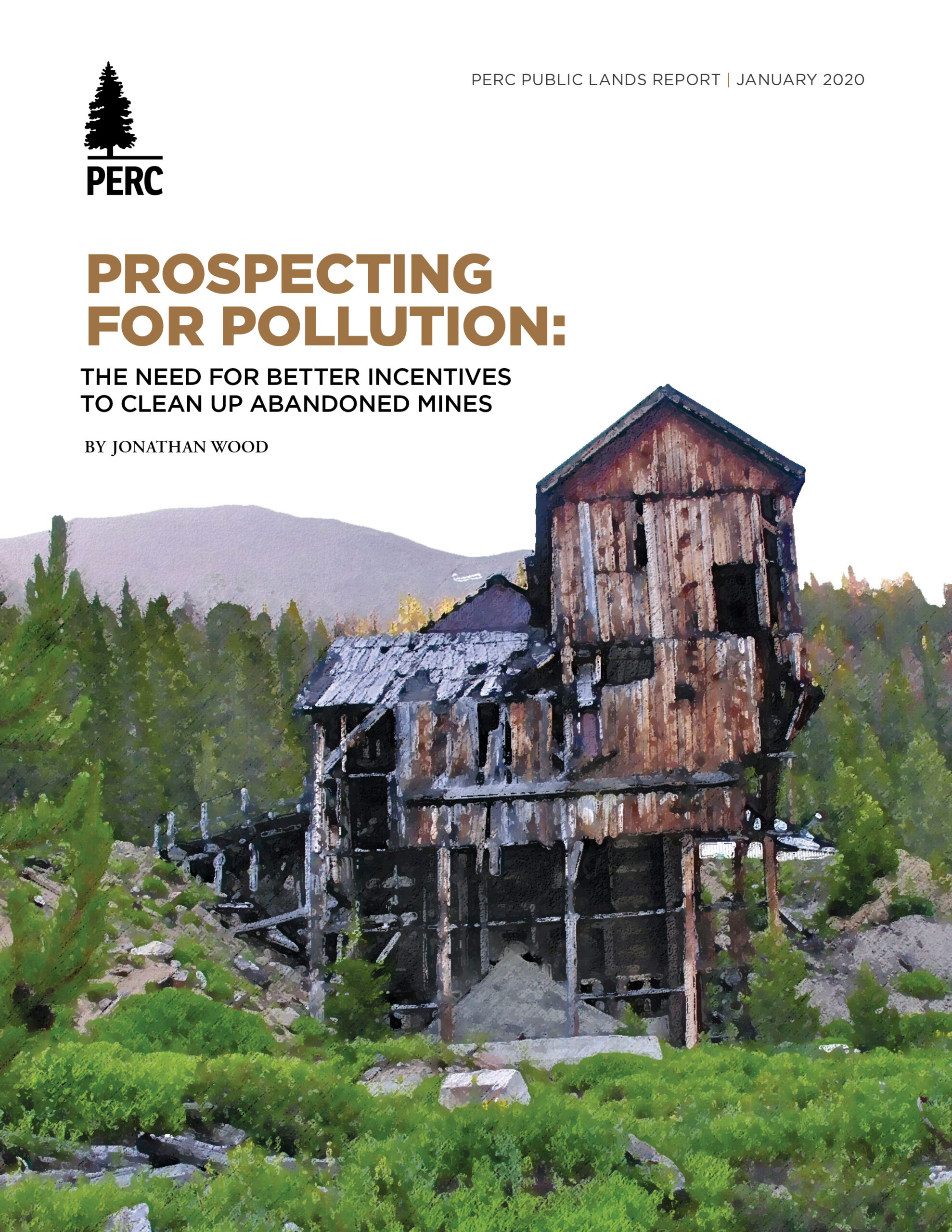No one knows exactly how many abandoned mines there are in the United States nor the full extent of environmental impacts they cause. Federal agencies estimate there are hundreds of thousands of such mines, impairing water quality in 40 percent of headwater streams in western states. Cleaning up these sites would likely cost tens of billions of dollars.
Yet quantity and expense are not the only challenges. Federal regulation complicates things further by providing a powerful disincentive for states, local governments, or private groups to assist in the efforts to clean up mines. Environmental regulations make parties working around such mines liable for the sites’ environmental impacts, meaning that no amount of care will protect Good Samaritans from liability should their clean-up efforts fail to end pollution entirely or should a tragic accident occur.
Removing regulatory disincentives faced by Good Samaritans is important, but policy should also actively reward efforts to clean up abandoned mines. Mitigating adverse environmental impacts from defunct mines benefits the federal government, downstream states and localities, downstream property owners, public land recreationists, conservationists, and others. An incentive framework that harnesses markets and allows Good Samaritans to capture a share of these benefits could lead to more cleanups and innovation.
Abandoned mines generate substantial environmental harms, especially in western states. It is critical not only to remove regulatory disincentives to clean-up efforts but also to replace them with positive incentives. Fortunately, markets can enable Good Samaritans to capture a part of the benefits they create, translating their work from treacherous to profitable.
Reviews
Jonathan Wood shines a bright light on the single greatest and least addressed environmental problem in the western United States. The more that people learn about the scope and scale of the abandoned mine problem, the more likely we are to address the funding and liability issues that have made cleaning up abandoned mines such a challenge.
— Chris Wood
President and CEO of Trout Unlimited
Jonathan Wood gives us a fresh look at the enduring and exceedingly frustrating problem of the remediation of historic mine sites. He convincingly argues for abandoning the status quo and fundamentally reshaping the incentive structure to promote voluntary cleanup activity.
— David Gerard
John R. Kimberly Distinguished Professor of Economics at Lawrence University
DOWNLOAD A ONE-PAGE EXPLAINER SUMMARY
Introduction
On August 5, 2015, Environmental Protection Agency employees and subcontractors breached the long-abandoned Gold King Mine in southwestern Colorado, releasing three million gallons of toxin-laden water into the Animas River watershed. Over the next few days, images of the suddenly bright orange river went viral, introducing the public to the environmental problem of abandoned mines—and the challenges of remediating them.
No one knows exactly how many abandoned mines there are nor the full extent of environmental impacts they cause. Federal land management agencies estimate there are hundreds of thousands of such mines, with impacts varying according to the type of mining that once occurred, the state of any mitigation efforts, and the sensitivity of the surrounding environment. Cleaning up these sites could cost more than $70 billion by one estimate.[1]
Quantity and expense are not the only challenges. Federal regulation complicates things further by providing a powerful disincentive for states, local governments, or private groups to assist in the effort to clean up mines. Environmental regulations make parties working around such mines liable for the sites’ environmental impacts, meaning that no amount of care will protect Good Samaritans from liability should their efforts fail to end the pollution entirely or should a tragic accident occur. Chris Wood, president of Trout Unlimited, and Mitch Krebs, president of Coeur Mining, aptly sum up federal policy as: “[I]f you touch it, you own it.”[2]
Eliminating this disincentive could encourage more stakeholders to undertake voluntary cleanups. However, this may not be enough to address a problem of this magnitude. To maximize the benefits of Good Samaritan interest in remediating abandoned mines, such efforts should be rewarded through positive incentives reflecting the numerous benefits Good Samaritans can provide the federal government and the public generally.
The Environmental Consequences of Abandoned Mines
Historically, federal lands were “free and open” to mining. At first, this was a liberty taken by miners without government sanction.[3] As hundreds of thousands of prospectors rushed from the East to the western territories in search of gold, they often sought their fortune on lands owned by the federal government.[4] This activity was largely governed by informal rules that emerged among miners themselves and were enforced through custom, self-organized mining districts, and, less commonly than you might think, violence.[5]
As western territories became states, their representatives sought formal recognition of claims and customary mining practices. This push culminated in the enactment of the Mining Law of 1872,[6] which codified the “free and open” policy,[7] formalized the system of mining-district regulation,[8] and established a process for miners to record their claims on federal lands and, in some circumstances, take title to those lands.[9]
These freewheeling policies had their intended effect of encouraging miners to stake claims throughout the West and populate the frontier.[10] However, mines from the territorial period and those discovered during the ensuing decades have generally been exhausted and abandoned. And the miners or mining companies responsible for them are deceased or defunct, causing any remaining interest in the mines to revert to the federal government.[11]
It is unknown how many abandoned mines exist. The Government Accountability Office estimates a minimum of 161,000 abandoned mines.[12] The true number may be closer to 500,000, according to federal land management agencies.[13] Not all of these are located on federal land; many can also be found on state or private land.[14] However, a significant share of abandoned mines are located on or within federal lands. Western states have the highest concentrations of abandoned mines, even though almost every state has abandoned mines.[15]
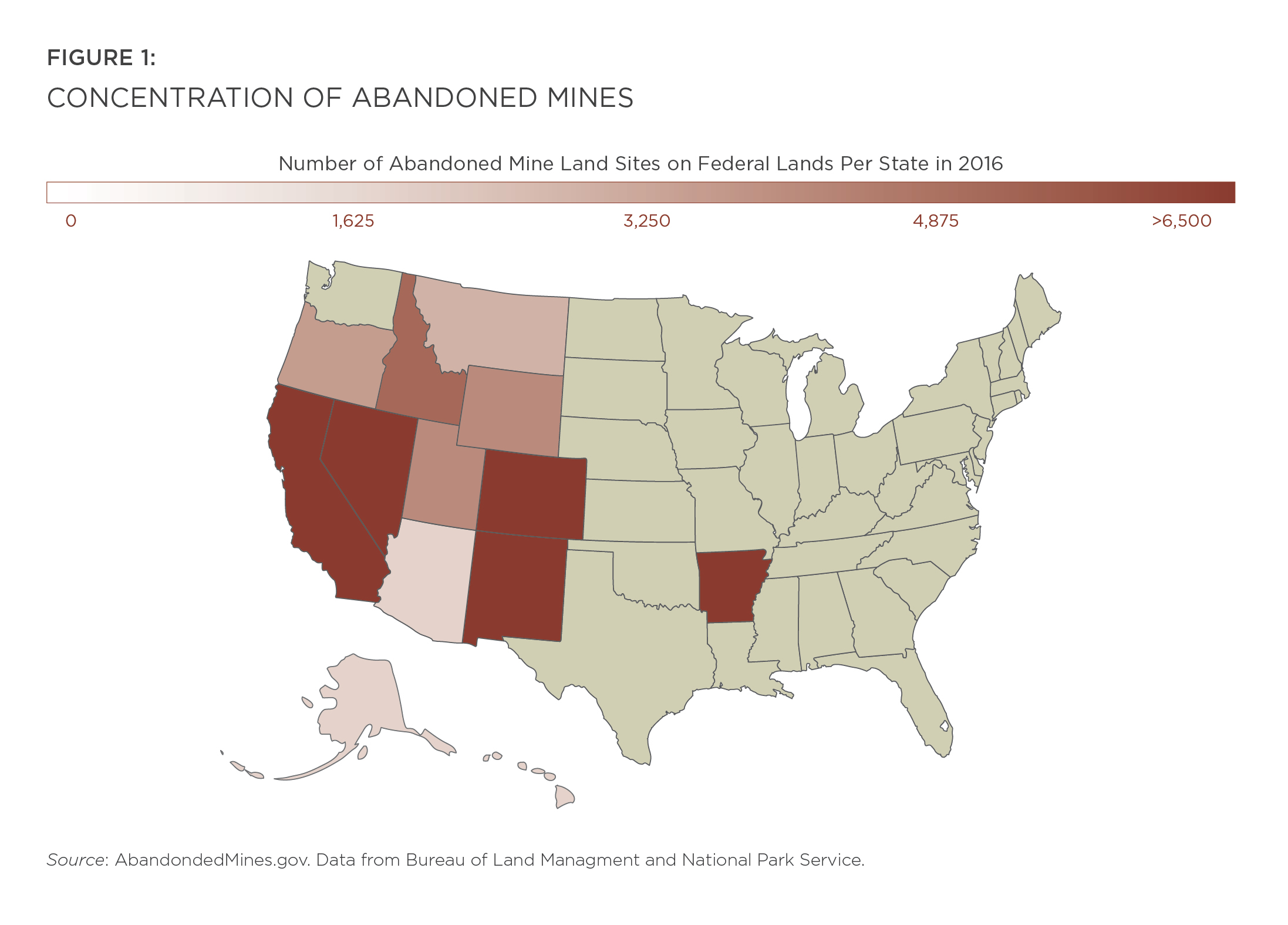
Although these mines have long ceased to produce valuable resources, they continue to produce pollution and other ill effects. The harm with which most people are now familiar, thanks to the Gold King Ming spill, is acid mine drainage—the release of water contaminated by heavy metals and other toxins.[16] Acid mine drainage can significantly worsen downstream water quality.[17] It can also harm fish and other animals, including endangered and threatened species.[18]
These impacts are not limited to disasters like the Gold King Mine; many abandoned mines continuously release smaller volumes of polluted runoff.[19] Although the amount of this pollution may seem small, its cumulative impact is significant. An estimated 110,000 miles of streams are impaired because of abandoned mines, including 40 percent of headwater streams in western states.[20]
With increased recreation on federal lands, abandoned mines also pose a human health hazard. They pose a risk of personal injury from a cave-in or unmarked shaft as well as exposure to contaminants.[21] When disturbed, abandoned mines can emit dust containing a variety of hazardous air pollutants, including arsenic, lead, and radionuclides.[22]
Just as the number of abandoned mines is unknown, the number that produce such impacts is unknown. But the figure is likely in the tens or hundreds of thousands. The Government Accountability Office estimates that at least 33,000 abandoned mines are contaminating surface water or groundwater, or more than 20 percent of the agency’s minimum estimate of the total number of abandoned mines.[23] If this same proportion is applied to the higher estimate of 500,000 abandoned mines, more than 100,000 mines may be contributing to adverse environmental outcomes.
Federal Cleanup of Abandoned Mines
Because a significant number of abandoned mines are found on federal property, responsibility for them falls largely on federal agencies. From 1998 to 2008, four such agencies—the Bureau of Land Management; the Forest Service; the Environmental Protection Agency; and the Office of Surface Mining, Reclamation, and Enforcement—spent more than $2.6 billion reclaiming abandoned mines.[24] The bulk of this burden was borne by the EPA, which administers the Comprehensive Environmental Response, Compensation, and Liability Act, more commonly known as the Superfund program.[25] Superfund is the primary federal law governing the cleanup of sites contaminated by hazardous substances and pollutants.[26] Under it, the EPA may order potentially responsible parties to pursue cleanups, with a right of reimbursement from other responsible parties.[27] Alternatively, the agency may undertake this work itself.
Cleaning up a site under Superfund is a laborious and costly process. It begins with the EPA evaluating sites and assigning them a priority.[28] Then an extensive environmental review of potential cleanup plans is required.[29] Once cleanup efforts are complete, the site must be monitored to ensure the project was effective and enforce any permanent restrictions on the property’s use.[30]
Superfund generally adopts a “polluter pays” approach, imposing retroactive, collective,[31] and strict liability[32] on parties involved in the original discharge and their successors. To maximize the potential funds available for a cleanup, the law casts a wide net for potentially responsible parties, including anyone who owns polluted land, once owned such land, or engaged in activities related to that land.[33] This could even include innocent landowners whose land has been contaminated by a neighbors’ activity.[34] Congress has developed several defenses to protect innocent landowners and other third parties, but the burden of proving these defenses falls on the party claiming them, making reliance uncertain.[35]
Superfund’s “polluter pays” approach can have the laudable effect of encouraging would-be polluters to internalize the costs associated with their activities, including costs imposed on others.[36] However, Superfund’s complicated approach can fail to achieve these benefits, especially as applied to parties whose activities long predate the legislation and who, obviously, could not have responded to the act’s incentives.[37] The approach can also backfire when the polluter cannot be found or has no resources to fund a cleanup. In such cases, financial responsibility falls to the EPA and, ultimately, taxpayers.
Responsibility for cleaning up abandoned mines on federal lands generally falls on the government, since parties who might otherwise be responsible are usually deceased or bankrupt, and the land has no current private owner to stick with the bill. In practice, the agency’s capacity to undertake this work is limited. Abandoned mines compete for priority with a variety of other polluted sites.[38] Despite the large cumulative effect, few abandoned mines can reach the top of the agency’s priority list based on their individual effects.[39] There are more than 1,300 polluted sites on the EPA’s national priorities list, with another 48 proposed for listing.[40] The average number of sites removed from the list per year is approximately 10 and has not exceeded 30 in recent decades.[41] This suggests that it could be 130 years before the EPA clears only the sites currently on its national priorities list, never mind the many sites that would inevitably be added to the list over that period.
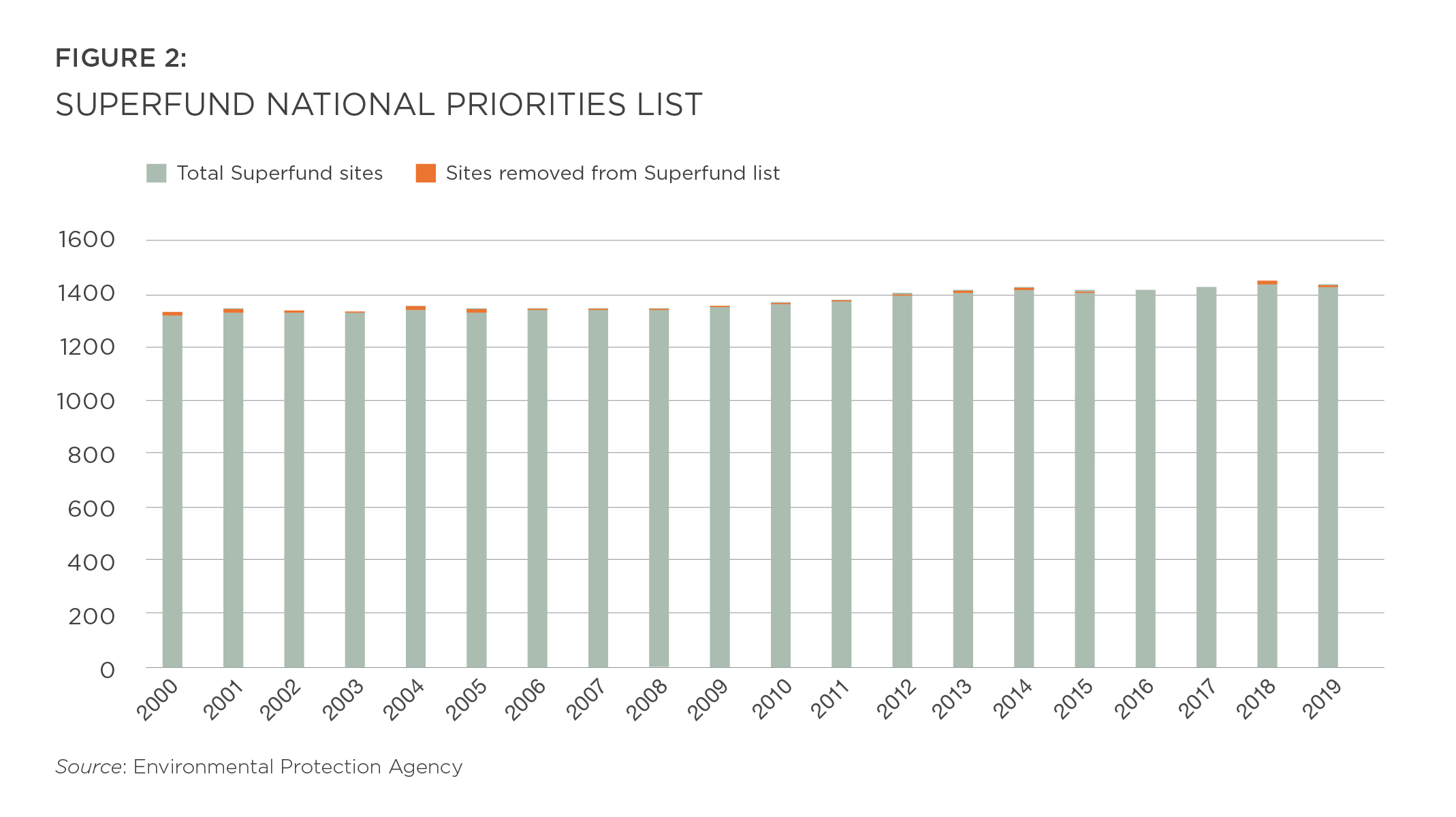
Perhaps more importantly, resources for EPA-led cleanups are limited. Initially, Superfund imposed an excise tax on the oil and chemical industries, creating a trust fund dedicated to cleanup efforts.[42] However, that tax lapsed in 1995, making cleanups solely reliant on appropriations from general tax revenues.[43] Congress did not increase appropriations to offset the lost excise-tax revenue, and the trust fund has been gradually depleted.[44] In fact, Congress has been reducing appropriations for the program. Annual appropriations have averaged approximately $1.1 billion in recent years, about half the amount appropriated in 1999, adjusting for inflation.[45]
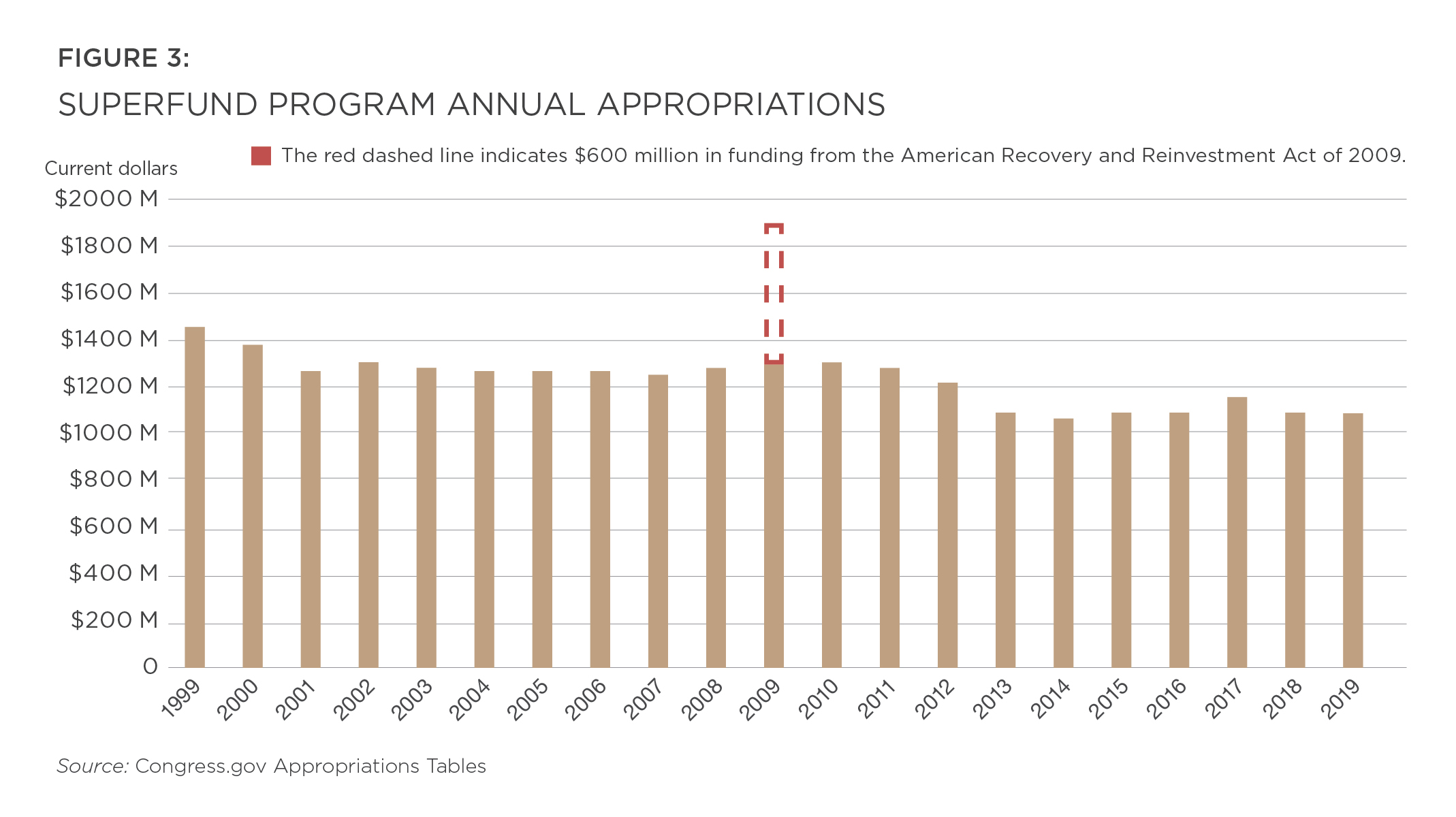
A billion dollars may seem substantial, but it is miniscule compared to the amounts required to clean up polluted sites. A 1993 report estimated the cost to clean up abandoned mines alone to be between $32 billion and $71 billion at the time, or approximately $56 billion to $125 billion in 2019 dollars.[46] Even cleaning up only abandoned mines found on federal lands could cost up to $21 billion, according to another estimate.[47]
Good Samaritans to the Rescue?
Barring a dramatic change in political winds, the resources needed to clean up abandoned mines will need to come from somewhere else. Fortunately, there’s a large, untapped source for additional funds: parties who would benefit from the cleanups. Local governments, private industries, and conservation groups often benefit from such cleanups and have demonstrated an interest in contributing to the effort.
For mining companies, the incentive to contribute is the prospect of recovering valuable minerals from the waste left over in abandoned mines. The potential profit opportunity comes from two sources. First, today’s technology is more advanced than that of a century ago, allowing minerals to be recovered that earlier miners missed.[48] Second, waste from older mines may contain minerals highly valued today that were unknown or worth less decades ago.[49] If a mining company can obtain the right to process such waste and keep the valuable minerals retrieved from it, remediation can be profitable.
Utility companies may also be willing to clean up abandoned mines. Water utilities incur substantial treatment costs, which can be increased by upstream pollution sources. If remediating an abandoned mine costs less than continuing to pay for ongoing treatment, a water utility may have good reasons to contribute to cleanups. Electric utilities may also benefit from remediating certain types of abandoned mines. In Virginia, Dominion Energy may soon use abandoned coal mines as pumped storage facilities—essentially, large batteries for wind and solar energy.[50] The number of abandoned mines suitable for such use, however, is likely small because of the volume required for efficient water storage.
Many conservation groups also have an incentive to contribute to cleanup efforts. For instance, acid mine drainage can make streams uninhabitable for fish, waterfowl, and other species. Sportsmen’s groups that value these animals for hunting and fishing may be willing to fund mine cleanups. Trout Unlimited and other groups—often referred to as Good Samaritans—have already undertaken such efforts, while indicating that they would like to do more. This suggests that, as is the case for many other areas of conservation funding, sportsmen could be major contributors to solving the abandoned mine problem.
Ultimately, no single stakeholder is likely to bear the full burden of remediating abandoned mines. But, cumulatively, they could bring significant resources to help address the problem, supplementing the federal government’s own efforts. Additionally, participation by these stakeholders could better inform the prioritization of abandoned mines, focusing on ones that have the greatest effect on drinking water supplies, environmental amenities, or potential for profitable remediation.
‘If You Touch It, You Own It’
Rather than encouraging these potential partners to join in the effort to remediate abandoned mines, federal regulations erect substantial obstacles. Two laws in particular—Superfund and the Clean Water Act—make voluntary participation in any cleanup a risky proposition. Unfortunately, efforts to eliminate these disincentives have been hindered due to bureaucracy, uncertainty, and political gridlock.
First, Superfund’s strict liability regime perversely discourages cleanup of polluted sites. The broad net the law casts for “potentially responsible parties” includes anyone who purchases a polluted area or undertakes certain work there, such as disturbing polluted soil. Therefore, by undertaking cleanup project, a Good Samaritan such as Trout Unlimited could become liable for all of the site’s pollution, despite having no role in its creation.
Recognizing this, in 1986, Congress enacted the Superfund Amendments and Reauthorization Act, which introduced a Good Samaritan defense to Superfund liability.[51] According to that defense, anyone “rendering care, assistance, or advice” to an EPA-led cleanup or at the direction of the on-site coordinator shall not be liable except for any harms caused by their own negligence. Thus, anyone qualifying for the defense avoids Superfund’s system of strict liability, according to which liability does not require carelessness or unreasonable behavior.[52]
However, Superfund places the burden of proving eligibility for this defense on the Good Samaritan. This means, in practice, that the Good Samaritan must undertake their remediation work uncertain of whether they will later need to prove they qualify for the defense—if, for instance, the EPA or another party undertakes a cleanup at the site and sues the Good Samaritan for reimbursement. Because Superfund liability routinely exceeds $100 million, even a small risk of a Good Samaritan being deemed ineligible for this defense discourages them from participating in a cleanup.
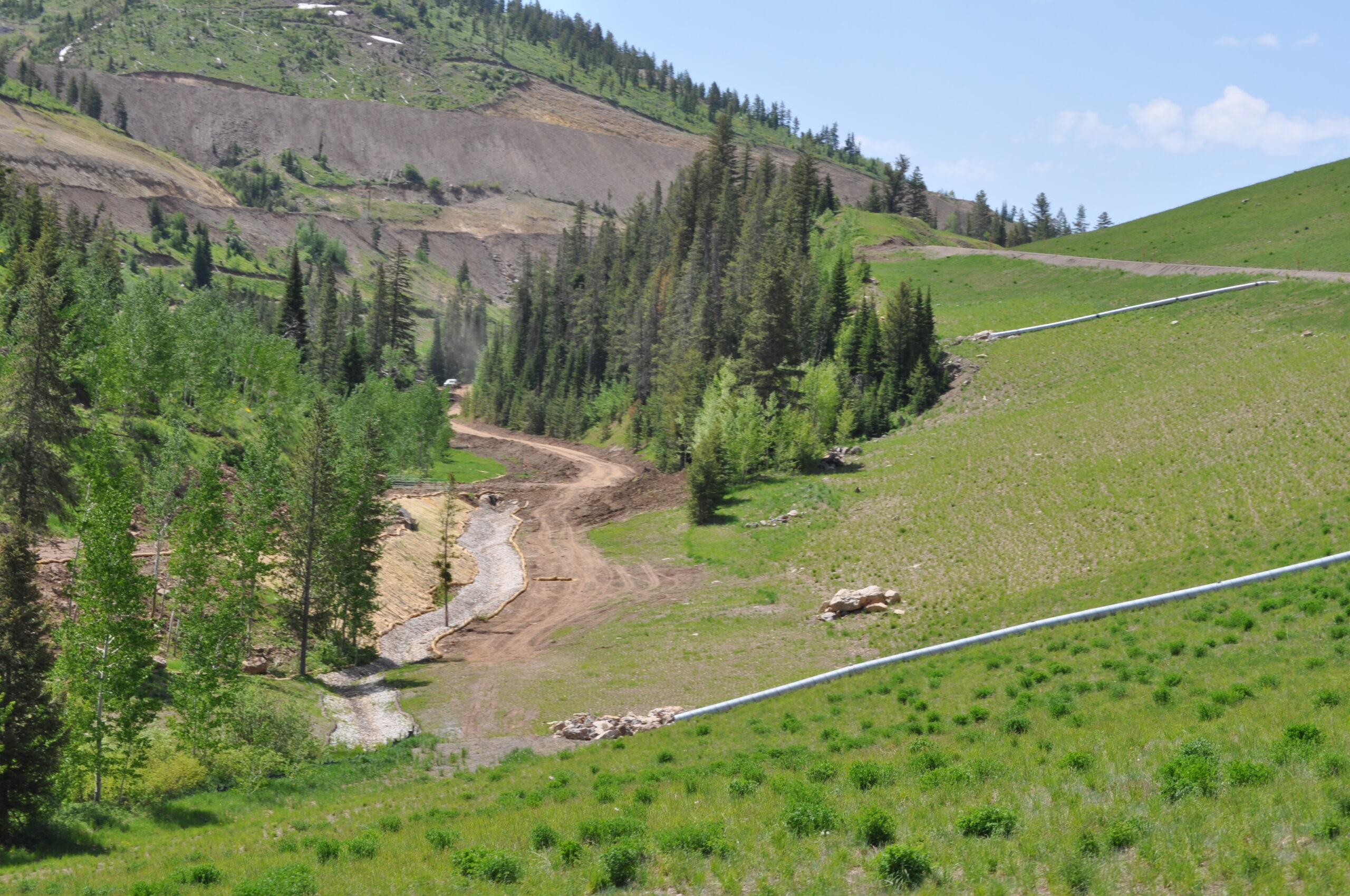
To address this problem, the EPA established the Good Samaritan Initiative in 2007 to provide greater assurances to third parties undertaking cleanup work.[53] Under the initiative, the agency will provide Good Samaritans a letter acknowledging their eligibility for the defense or a settlement agreement providing more formal protection. The EPA has also given regional administrators guidance for reviewing Good Samaritan projects and providing these assurances to participants.[54] This reform is beneficial but incomplete. Its shortcomings have limited its effectiveness to spur Good Samaritans to invest in cleaning up abandoned mines.[55]
These shortcomings include that the initiative was issued as mere “guidance”—an informal type of agency action which can be revoked or changed at any time and which expressly disclaims private parties’ ability to rely on it.[56] Once final, a settlement agreement is binding on the EPA, but negotiating one requires a substantial agency commitment of time and resources, which is often lacking. Indeed, the EPA encourages regional staff to issue form letters to Good Samaritans to avoid “having to invest time and resources in negotiating a formal settlement agreement[.]”[57] But this also means that Good Samaritans do not receive the binding assurances of a settlement agreement.
As a result of the Clean Water Act’s obstacles, Good Samaritans are “working with one hand tied behind [their] back.” The potential liability is so great that they cannot risk remediating any pollution source that would qualify as a point source under the act.
The process established by the initiative can also be cumbersome for Good Samaritans, especially for more ambitious projects. For instance, the initiative requires would-be Good Samaritans to investigate whether there are any potentially responsible parties for the site, which may be costly to identify. It also requires them to reveal the identity of their donors for the project, which may hinder fundraising efforts.[58] Good Samaritans may be required to pay the EPA for its costs to oversee the settlement.[59] And any failure to satisfactorily perform (in the EPA’s judgment) any part of the agreement could result in the Good Samaritan enjoying no protection whatsoever.[60]
The Good Samaritan Initiative is also an incomplete fix because it fails to solve the other significant obstacle to these cleanups: the Clean Water Act.[61] The act prohibits the unpermitted discharge of pollutants from any point source—any discrete conveyance such as a pipe, ditch, or device—into a federally regulated water.[62] Where pollution from an abandoned mine cannot be abated entirely, the treatment used to reduce pollution levels will likely involve some point source that could trigger liability. For instance, a Good Samaritan may construct a series of settlement ponds between a horizontal mine opening, or adit, and a regulated water to absorb some of the pollution before the treated water continues downstream. Because the ponds and the channels directing water to them would constitute a point source, any remaining pollution in the water when it leaves the treatment process could require a Clean Water Act permit, even though the ponds were constructed to reduce pollution, not to discharge it. This is the “if you touch it, you own it” policy described by Chris Wood and Mitch Krebs.[63]
Indeed, the Clean Water Act has already ensnared Good Samaritans. In the 1970s, for instance, the East Bay Municipal Utility District sought to mitigate pollution from the abandoned Penn Mine, which adversely affected drinking water sources.[64] Building several dams and containment ponds was cheaper than the utility’s treatment costs, giving it an incentive to undertake this work.[65]
Unfortunately, the containment ponds occasionally exceeded their banks during periods of heavy rain, causing infrequent discharges of pollution to reach the stream.[66] A local environmental group sued the utility, claiming the discharges violated the Clean Water Act.[67] In Committee to Save Mokelumne River v. East Bay Municipal Utility District, the Ninth Circuit ruled against the utility, holding that it would be liable for any discharge regardless of the net effects of its efforts.[68]
The effects of this decision were not lost on the court. Judge Ferdinand Fernandez penned a concurrence acknowledging that the case “will not serve the long-term purpose of bettering the aquatic environment.”[69]
[I]t takes no genius or epopt to see what the message will be. Do nothing! Let someone else take on the responsibility. Let the water degrade, let the fish die, but protect your pocketbook from vast and unnecessary expenditures.[70]
Despite the negative consequences of such a ruling, Judge Fernandez explained, the court’s hands were tied; precedent and the statute’s text required liability to be imposed.[71]
The silver lining of the court’s decision in East Bay Municipal Utility was that it left open the possibility that a Good Samaritan could obtain a Clean Water Act permit to cover their activities. Unfortunately, courts would later close this opportunity, at least for the most polluted waters.
In 1998, Carlota Copper Company sought a stormwater permit for a copper mine outside of Miami, Arizona.[72] The EPA saw the company’s plans as an opportunity to clean up a nearby stream heavily polluted by an abandoned mine.[73] The agency proposed the company apply for a more burdensome permit that would allow it to discharge directly into the creek and avoid some mitigation costs in exchange for remediating the abandoned mine.[74] The company accepted the proposal, ultimately spending $2.5 million to remove 120,000 tons of waste from the abandoned mine.[75]
The company did not receive its benefit of the bargain, however. When the EPA issued the company’s permit, local environmentalists challenged it as violating the Clean Water Act. A federal court agreed, holding that the law does not authorize the agency to issue discharge permits for streams already designated as impaired, even if the new discharge is more than offset by reducing other pollution sources.[76] Thus, the EPA may not trade permits for abandoned mine remediation in precisely the streams where such trades could have the greatest benefit.
In 2012, the EPA issued guidance suggesting factors that the agency would consider when determining whether Good Samaritans are liable under the Clean Water Act.[77] For instance, it suggests that settlements reached under the Good Samaritan Initiative could require the Good Samaritan to engage in ongoing monitoring of the site—in other words, meaning that the cleanup would never formally end. But few Good Samaritans want to be forever tied up in this way.
The EPA’s guidance also suggests that Good Samaritans can avoid Clean Water Act liability by taking the opposite tact, ensuring that they have no access to the site or role in monitoring it once the initial work is completed.[78] But Good Samaritans likely do not want to tie their hands in this way either because some monitoring or maintenance may be necessary to ensure a return on their investment. Besides, this just shifts the liability from the Good Samaritan to someone else—whoever controls the site after the Good Samaritan leaves. If that person’s consent is necessary for the Good Samaritan to access the site initially, they’ll block the project at the front end to avoid liability at the back end. Moreover, as with the Good Samaritan Initiative, the 2012 memorandum is mere informal guidance that can be withdrawn or changed at any time, limiting Good Samaritans’ ability to rely on it.
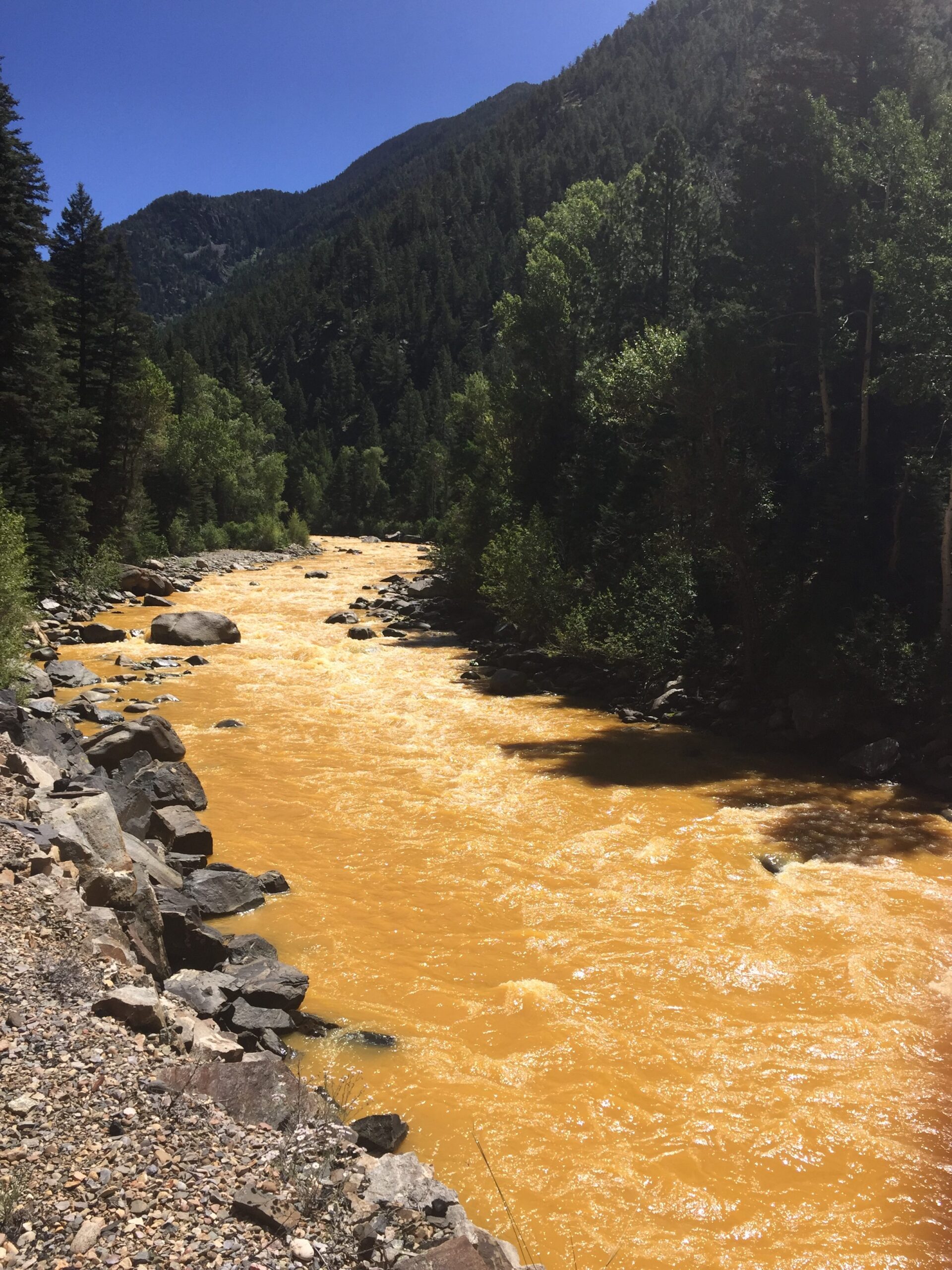
As a result of the Clean Water Act’s obstacles, Good Samaritans are “working with one hand tied behind [their] back,” according to a Trout Unlimited blog post.[79] The potential liability is so great that they cannot risk remediating any pollution source that would qualify as a point source under the act.[80] This means that work has been limited to removing mine tailing piles, which can be removed or capped without creating a point source.
This work enables water quality improvements but severely limits the extent of such improvements. In Colorado, for instance, Trout Unlimited has been removing tailings from abandoned mines that pollute Clear Creek west of Denver.[81] This has improved water quality. But unless the group can remediate an upstream adit, which would clearly qualify as a point source, the stream cannot support aquatic life.[82] Trout Unlimited notes that to fully address the problem of abandoned mines, Good Samaritans “need a legislative solution that allows them to address the rest of the pollution—the leaching mine openings themselves.”[83]
Untie Good Samaritans’ Hands
Eliminate Disincentives
Any legislative solution should begin with eliminating the disincentives for mine reclamation created by the Superfund and Clean Water Act strict-liability regimes. The “polluter pays” principle reflected in those regimes can encourage polluters to face the costs of their actions. But where there is no one to internalize those costs, it can have the opposite effect of discouraging the mitigation of harm. Imagine a bankruptcy process that did not discharge debts but, instead, tethered them in perpetuity to any assets. Rather than encouraging financial responsibility, such a regime would create toxic assets deprived of all value. Well-intentioned strict-liability environmental regulation has the same effect for abandoned mine pollution.
Cleaning an abandoned mine is no easy task, as the Gold King Mine disaster shows.[84] To ensure the task is undertaken responsibly, Good Samaritans should be liable if they behave negligently or otherwise make matters worse. One legislative proposal, for instance, would authorize Good Samaritan permits and then limit liability to violations of the permit that result in environmental conditions worse than those that existed before the cleanup was undertaken.[85] This would more closely mirror negligence liability.[86] If a Good Samaritan exercises due care, they won’t be liable for unforeseeable consequences. But if they fail to do so, they will bear the cost of any harm caused.
Such an approach replaces the counterproductive strict-liability regime with one more likely to encourage Good Samaritans to pursue cleanups, while also ensuring that any work is undertaken responsibly. Importantly, it makes liability turn on things within the Good Samaritan’s control, rather than threatening unlimited liability if conditions in a mine are more challenging than anticipated or if technology fails.
Only Congress can make this change. It should reform Superfund and the Clean Water Act to shield Good Samaritans from liability, so long as they do not behave negligently, subject to clear standards that Good Samaritans can reasonably rely on.
Limit Red Tape
Limiting liability only to replace it with red tape would undermine the positive effects of reform. Therefore, any procedural or substantive hoops that would-be Good Samaritans must jump through should aim to maximize benefits while avoiding unnecessary costs. The EPA’s past efforts to encourage Good Samaritans, unfortunately, have failed in this regard by establishing processes too cumbersome for the agency and Good Samaritans to navigate at the scale needed to solve the problem.
First, if a Good Samaritan is required to submit information along with a permit, that information should be limited to the risks at the site and the Good Samaritan’s ability to perform the mitigation work. It’s reasonable to require documentation of a site’s condition, pollutants present, and the plan for addressing them. A competent Good Samaritan should collect this information anyway in preparation for their work.
But if Congress or the EPA imposes extraneous requirements, this increases costs without reducing environmental risks. The EPA’s Good Samaritan Initiative and several proposed bills require, for instance, proof that there are no potentially responsible parties that could be fiscally responsible under Superfund.[87] For older mines, this could require a complex forensic accounting, including the tracing of companies and assets over decades. Requiring Good Samaritans to undertake this effort increases costs without any likely benefit. This is because there is already a strong incentive to undertake such searches where a deep-pocketed responsible party is likely to be found, namely that the party can be required to pay for any cleanup.[88] When would-be Good Samaritans do not undertake the search, this suggests that the odds of finding a potentially responsible party, that party having the resources to fund a cleanup, and the EPA being enticed to order a cleanup, are too low to justify the costs. Requiring Good Samaritans to bear these costs anyway only saps resources that could otherwise fund cleanups. Indeed, the agency itself often foregoes searching for certain classes of potentially responsible parties because the odds that any of them will be liable for cleanup costs and able to pay are too low.[89]
To avoid this problem, reform should limit the paperwork required of Good Samaritans to evidence of the environmental conditions at the site and their ability to carry out a plan to improve them.

Second, if Good Samaritans are required to obtain a permit, the process should be streamlined as much as possible. For instance, although abandoned mines can present unique challenges, the most common remediation methods could be incorporated into general permits under Section 402 of the Clean Water Act (concerning point-source discharges) and nationwide permits under Section 404 (concerning dredge-and-fill discharges). A general permit under Section 402 categorically authorizes certain types of activities with similar types of discharges and environmental risks.[90] By predetermining the precautionary and mitigation measures required by an activity, general permits substantially reduce permit delays and uncertainty.[91] Similarly, a nationwide permit under Section 404 authorizes similar activities, subject to standardized conditions and mitigation requirements.[92] In either case, a Good Samaritan could quickly obtain the benefits of the permit by filing a notice with the agency, providing information about the project, and complying with the conditions imposed by that permit.
This approach would create substantial savings for the EPA by avoiding the need to recreate the wheel each time a permit is sought. Unfortunately, the agency has given no general guidance on best practices for cleaning up abandoned mines.[93] But it has a wealth of knowledge based on its own experience remediating abandoned mines that could inform the development of such permits. Again, the focus of any conditions imposed on such a permit should be to minimize environmental harms while also minimizing costs to Good Samaritans.
If Congress requires Good Samaritans to obtain a permit for their work, it should also direct the EPA to identify and publicize best practices and incorporate these practices into binding nationwide permits, model settlement agreements, and other tools that reduce red tape.
Reduce Litigation Risk
Finally, Congress and the EPA should endeavor to limit the unnecessary risk litigation poses to Good Samaritans. The Clean Water Act, like many federal environmental statutes, authorizes “citizen suits,” meaning anyone can sue to enforce the law.[94] In practice, such suits play a significant and often beneficial role in enforcement.[95] However, they can also be costly and unnecessarily disruptive.[96]
In the Carlota Copper case described above, for instance, a citizen suit upended a beneficial compromise negotiated between the EPA and a mining company. By denying the company its benefit of the bargain, the litigation reduced the likelihood of such beneficial trades in the future. At the same time, barring litigation also presents risks of its own, such as allowing a project that would cause significant environmental harm to move forward. Therefore, the solution likely isn’t to bar litigation entirely but instead structure incentives so that beneficial litigation continues, disruptive litigation is stymied, and litigation risks for well-designed cleanup projects are minimized to the extent practicable.
Under Superfund, the EPA has reduced this risk through pre-negotiated settlement agreements, which define the Good Samaritan’s responsibilities and cap potential liability.[97] However, the availability of citizen suits makes this option impractical under the Clean Water Act because a Good Samaritan is unlikely to be able to negotiate with every potential citizen-litigant in advance.
Requiring lawsuits to be filed quickly, however, could reduce the risk of litigation and provide certainty before a Good Samaritan devotes substantial resources to a cleanup. Currently, lawsuits can be filed years after a permit is issued or work has begun.[98] This means that the Good Samaritan may have to undertake their work uncertain of the status of any permit or limitations on liability. Requiring any lawsuits to be filed shortly after a permit is issued or a site study has begun could provide certainty to Good Samaritans without unduly frustrating the benefits of environmental litigation. California, for instance, requires challenges to environmental reviews under the California Environmental Quality Act to be filed within 30 days.[99] By setting a short deadline, this law gives project proponents early notice of whether litigation is a risk, giving them an opportunity to reconsider how they allocate their resources. But it hasn’t prevented litigation where interested parties have identified environmental concerns.[100]
How to Encourage Abandoned Mine Cleanups
Removing regulatory disincentives faced by Good Samaritans is important, but to maximize Good Samaritans’ potential, policy should actively reward their efforts. Mitigating adverse environmental impacts from abandoned mines benefits the federal government, downstream states and localities, downstream property owners, public land recreationists, conservationists, and others. An incentive framework allowing Good Samaritans to capture a share of these benefits could lead to more cleanups and innovation.
Reward Good Samaritans for Reducing Federal Liabilities
For one thing, Good Samaritan projects would reduce the federal government’s financial liability for abandoned mines. As noted above, this total burden likely exceeds $70 billion—several times larger than the EPA’s total Superfund budget.[101] Good Samaritan reforms at the state level show that such reforms can reduce these burdens. In 1999, Pennsylvania enacted a Good Samaritan law to encourage the cleanup of abandoned mines and other polluted sites.[102] The law requires Good Samaritans to demonstrate to the state Department of Environmental Protection that they did not cause or contribute to the existing pollution problem, that they have the resources to undertake the project, and that the project is designed soundly.[103] As of 2015, more than 50 Good Samaritan projects had been approved and completed under the law.[104] These projects have saved the state as much as $85,000 per project.[105]
Abandoned mines also present another underappreciated financial liability for the government—potential tort liability. In 2014, the Court of Appeals for the Seventh Circuit held that agencies can be sued under the federal common law of public nuisance when their activities cause or contribute to harms to neighbors. In Michigan v. U.S. Army Corps of Engineers, the Court held that an agency operating canals could be liable if it failed to take reasonable measures to prevent the spread of invasive species through those canals.[106]
Although the federal agencies that own land underlying abandoned mines deny liability for the mines’ effects, the case for liability is plausible. True, the main activities that caused these effects are in the distant past. But the same was true in Michigan, as the canals at issue in that case were built in the early 20th century, and the invasive species was introduced in the 1970s. Yet liability was still possible because the agency’s current activities affected the spread of the species. Applying this logic to abandoned mines, federal agencies’ land management activities in the vicinity of abandoned mines could trigger nuisance liability if those activities affect the mines’ environmental impacts, unless the agency takes all reasonable steps to reduce those impacts.
Even if federal funding for abandoned mines cleanups increased substantially, it will likely be more effective if used to encourage the work of Good Samaritans, since the funds would only need to cover a portion of the project costs. Federal support could be offered to Good Samaritans, for instance, through a matching-funds program or through contributions in proportion to the amount of pollution reduced or another pay-for-performance metric. For some projects, such payments may be the difference between a cleanup being profitable (where recovery of resources from mine waste is a motivation), financially feasible (where environmental concerns are the priority), or neither.
In addition to leveraging limited federal funds, financial support for Good Samaritan projects would benefit from dispersed local knowledge. Letting states and localities, utilities, mining companies, and conservation groups play a role in selecting which abandoned mines should be prioritized will tend to be more effective (and cheaper) than relying on top-down decisions from the EPA.
Markets for Water Quality
Markets could also play this role by incorporating abandoned mine cleanups into water-quality trading schemes. The Clean Water Act generally relies on a command-and-control approach, with the EPA or a state agency regulating individual point sources and mandating the mitigation measures taken. One downside of this approach is that it focuses pollution mitigation efforts only on the sources subject to regulation, treating others as part of the baseline. Thus, for instance, point sources have reduced their pollution dramatically in recent decades, but non-point sources (such as urban and agricultural runoff) have been much slower to improve. Because the low-hanging fruit has been exhausted in the former context, every additional amount of pollution reduction may be far more expensive than the same reduction from other sources.
Markets can solve this problem by allowing trades across sources, with relative prices determining how varying sources reduce their pollution. Recognizing this, the EPA has long supported market-based programs, like water-quality trading, and has established dozens of them for individual watersheds or streams.[107] For instance, a water-quality trading program for the Tar-Pamlico River in North Carolina substantially lowered the cost of pollution reductions. Reducing a unit of nitrogen pollution in that river would cost a point source $35, but area farmers could achieve the same benefits at a cost of only $13. By allowing trades to occur between different sources, the market allowed large gains from trade.[108]
The EPA could create a similar market for the 110,000 stream miles impaired by pollution from abandoned mines. Even more so than non-point sources, the pollution from abandoned mines has been treated as part of the baseline, rather than a regulated source. As the Carlota Copper example discussed above shows, remediation of abandoned mines may be cheaper than avoiding pollution from another source. Thus, if Good Samaritans received a credit for the pollution they mitigate, which could be sold to pollution sources and offset their permitting requirements, this could create a significant profit opportunity.
There are criticisms of water-quality trading programs, to be sure. Where trades depend on models to estimate pollution reductions, as is often the case for nutrient pollution from runoff, the accuracy of the model may be disputed.[109] Trading programs may also result in pollution “hot spots” where additional pollutants are discharged to already heavily polluted areas in exchange for reductions in relatively healthy streams.[110] And, finally, since trades may be motivated solely by the parties’ desire to comply with regulations, enforcement requires effort by regulators or outside groups.[111]
However, these concerns are reduced in the abandoned mine context, or they could be mitigated. Rather than relying on speculative modeling, reductions in acid mine drainage could be measured by comparing historic pollution levels against current levels. And the nature of that pollution—relatively rare toxins rather than ubiquitous fertilizer byproducts—makes monitoring and enforcement somewhat easier. Finally, if past expressions of interest in Good Samaritan cleanups is an indication of future interest, conservation groups would participate in many of these transactions and have an incentive to see that environmental benefits are realized.
In some cases, the pollutants generated by abandoned mines may not be the same pollutants commonly generated by polluting activities today. This would complicate the market approach but need not be an insurmountable obstacle. An exchange rate could be established for various pollutants to ensure that the market clears. A ton of arsenic pollution removed from an abandoned mine, for instance, could offset a different quantity of nitrogen or other pollutant discharged from another source. Identifying such a rate would not be easy and could vary by water body. But the benefits could be substantial, and, in practice, the EPA need only identify an exchange rate for a few of the most significant pollutants, particularly ones that are most costly for other sources to avoid.
Expanding Markets to Mine
Finally, broader reforms of federal mining policy could contribute needed incentives. Recently, legislation has been proposed that would replace the “free and open” policy of the Mining Law of 1872 with a leasing program similar to the ones that govern oil drilling, grazing, and other federal land uses.[112] Funds generated by such leases could be set aside for the remediation of abandoned mines, as is currently the case for coal mines.[113]
Yet any such reform should aim to avoid the pitfalls of these past cases. For instance, federal leasing programs often include “use it or lose it” principles that can distort incentives and prevent markets from allocating resources efficiently. Conservationists who prefer to see a leased area conserved rather than mined or grazed, for example, have no market recourse to outbid their extractive competitors.[114] Currently proposed reforms of the Mining Law of 1872 would repeat these errors, threatening to worsen rather than resolve political conflict over mining.[115] Excluding conservationists from the bidding process also artificially reduces the revenue that could be raised.

Conclusion
Abandoned mines generate substantial environmental harms, especially in western states. Unfortunately, federal environmental regulation worsens rather than solves this problem by erecting significant disincentives against stakeholders undertaking cleanups of such mines. So long as federal funds for cleaning up abandoned mines remain limited, it will be critical not only to remove these disincentives but also to replace them with positive incentives. Fortunately, markets can enable Good Samaritans to capture a part of the benefits they create, translating their work from treacherous to profitable.
Download the full report, including endnotes and references.
